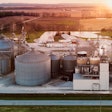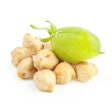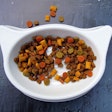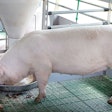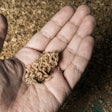Technology drives innovation. In the grain industry, this adage can be applied to everything from automation to invoicing. Notably, post-harvest grain quality measurement technology has proven to be a critical, ever-evolving tool for the industry. Quick and accurate mycotoxin testing has improved feed safety and blending techniques, however, they are limited in their ability to provide a snapshot of quality attributes at an individual-kernel level.
Analyzing singular kernels could be the key to developing higher quality grain varieties. Identifying the moisture, protein and oil content of a single seed gives breeders and geneticists the foundation seed they need to develop optimal-quality grains.
Although today there are few applications suitable for commercial grain handling facilities, single-seed analyzers may someday be used to detect mycotoxins and other post-harvest damage. As the precision, accuracy and speed of these instruments improves, they may become commonplace in grain handling facilities across the nation.
Feed & Grainspoke with the developers of these instruments and some of the foremost leaders in grain science to understand the impact single-seed analyzers may have on the industry.
Quality starts with the seed
Universities and USDA-ARS (Agricultural Research Service) labs across the country spend a significant amount of time and financial resources researching optimal ways to maintain grain quality. Their work has led to many of the best management practices used today with regard to aeration, drying and pest control. But Floyd Dowell, agricultural engineer, USDA-ARS in Manhattan, KS, notes that grain quality management shouldn’t begin post harvest, but rather before the crop is even planted.
“A lot of our efforts have focused on cleaning up harvested grain and testing for defects to ensure feed and food quality and safety,” says Dowell. “But instead, if we spend more time focusing on breeding for quality characteristics, we won’t have to clean them up later because we’ve done a better job ensuring a safe, wholesome supply.”
汤姆·皮尔森,美国农业部农业工程师-ARS lab in Manhattan, has developed a full spectrum single-seed analyzer that captures color images of individual kernels and sorts them into either the accepted process stream or diverts them out based on visual characteristics.
Calibrating the instrument involves running a small sample through the machine to collect image data on what should be accepted and what should be rejected. It uses a pattern recognition routine that matches the visual characteristics of the kernels as they come off the shoot to sort them into two piles. Breeders can use the sorting application for several purposes, including diverting weed seeds away from grain seeds, resulting in less foreign material upon harvesting.
“Using image analysis to sort grain can be used not only to increase quality, but to increase value, as well,” says Pearson. “For example, when creating wheat foundation seed, red and white wheat must be sorted to purify it, otherwise you end up with wheat of different classes, lowering its value. In the case of flax, you separate yellow from brown flax, or purify the yellow flax, which increases its value.”
Paul Armstrong, agricultural engineer, Engineering and Wind Erosion Research Unit of USDA-ARS, is the developer of a single-seed Near Infrared (NIR) instrument applicable to corn, soybeans and other large seeds. There are only three of these instruments in the United States, according to Armstrong.
Grain science departments at Iowa State University, the University of Florida and Kansas State University are using the instruments to enhance their breeding programs.
“It uses the same general operating principle used in bulk NIR instruments that feed mills have to measure feed components, except at a single-seed level,” says Charles Hurburgh, professor, department of agricultural and biosystems engineering at Iowa State Universtiy. “The seed passes down a short LIGHT tube that is illuminated from the top and bottom with NIR light, and there are detectors around the side of the barrel, measuring the amount reflected off of the seed.”
The nondestructive aspect of single-seed NIR analyzers makes it an attractive device for breeders, according to Dirk Maier, professor and head, department of grain science and industry at Kansas State University.
“When wheat breeders are iterating their varieties, they have very small samples before it goes into production, which is a multiple year cycle,” Maier says. “You don’t want to destroy the kernels within that miniscule sample to do quality analysis so you can preserve the seed for the next generation. If you can run a small sample through this single-kernel NIR, then you can get some quality measurements without destroying the kernel and go on doing the propagation work, saving time, money and the relatively small amount of seed that’s available in those early generations.”
对这一点Hurburgh补充道:“一般来说,当你start to develop a hybrid or a soybean variety, your basic stock might fit in a Dixie cup. You’d like that Dixie cup to remain pretty pure. This instrument isn’t going to clean up a truckload, but it’ll clean up a coffee cup.”
Using single-seed analyzers to identifying foundation seed in fewer iterations helps bring new varieties to market more quickly.
“This [instrument] is an enabling technology to accelerate plant breeding for whatever aspects you calibrate the instrument for — moisture, protein or oil” says Hurburgh. “By isolating seeds that may have what you’re looking for at an early developmental level, you can accelerate the ability to develop higher quality material. It won’t do it by itself, but it will make the process easier and less expensive to do.”
Armstrong is currently working with soybean breeders to create a high-oil, high-protein variety; the team uses his single-seed NIR analyzer to sort soybeans that have both the qualities they’re looking for. Those seeds may be genetically different from the rest of the crop, and will be planted to create the next generation of this new optimal-quality variety.
Measuring quality variability
Today, single-seed analyzers improve grain quality through genetics and plant breeding, but there is potential for other applications, including variability and toxin testing.
Different quality attributes can affect how a feedstock should be processed to achieve the desired end-product. At an ethanol facility, for example, there may be a wide variability in the starch content of a bulk sample of corn. Taking measurements on the bulk sample will give an average of the starch content, but not of the individual kernels. Armstrong says a processor could use a single-seed analyzer to sort by starch variability, allowing the plant to modify its process based on the measurements.
“There are similar theories along the lines of soybean oil extraction,” says Armstrong. “The variability of oil within the beans may affect some of the processes, so rather than looking just at the average oil, you could measure the variability of oil to provide a better indicator of how you can maximize the extraction process.”
The main barrier to using single-kernel analyzers at commercial facilities today is speed. The throughput for wheat on Pearson’s full spectrum analyzer is about 200 kernels/second, or 20 to 25 kilograms/hour. Armstrong’s NIR analyzers measures a mere 3 kernels/second. Although it is possible to run parallel systems and double or triple the throughput, the current speed for an individual instrument is not ideal for millers or commercial processors. But over time, as the technology improves, the variability of specific seed components may become routinely measured.
Toxin testing
Single-seed analyzers may one day be able to detect mold and toxins, but some voice uncertainty because their presence is measured in the parts per million or even billion.
“That’s probably below the resolution of the instrument, so it may take two to three generations of improvement on the technology before that’s possible,” Hurburgh says. “We’ll probably get there, but it’s a little bit of a stretch simply because the toxins are at very low levels.”
Although toxin presence within a single kernel would be difficult to detect by NIR, it is capable of detecting mold damage and segregating damaged kernels from healthy kernels.
“If you can correlate mold damage to the probability of having aflatoxin, then that’s one application that might be useful for testing on an individual-kernel level,” says Armstrong.
Pearson’s full spectrum single-seed analyzer is heading in that direction, but admittedly is incapable of identifying toxins based purely on visual indicators.
“It can detect the visual symptoms of several kinds of fungal damage, but we haven’t been able to quantify it,” says Pearson. “Fungal damage could indirectly be related to toxins, but the instrument would never be able to detect mycotoxins directly.”
Nevertheless, Maier predicts that in time there may be a use for single-seed analyzers at large-scale grain handling facilities.
“We might be a little ways off in understanding how single-seed analyzers would be practical in large-scale handling,” says Maier. “But take for example what happens at an elevator, where they take a relatively small sample off a truck. There might be a practical application on that scale. You wouldn’t necessarily run the whole truck over a sorting machine, but you could run a sample in a relatively small timeframe. For the FGIS, export facilities and high-quality producers, there are potential applications.”
Greater expectations
If single seed testing becomes more prevalent, customers both domestically and worldwide may begin demanding higher quality specs in their contracts.
“If the single-seed analyzer can be demonstrated as a useful measurement tool for the general grain industry, you’ll see that processors will begin expecting higher quality from their suppliers, both producers and grain handlers,” says Armstrong.
Dowell adds, “I think you see, particularly with the export markets, if you can measure it, then someone will expect you to remove it. For example, when aflatoxin was first being regulated and the testing technologies improved, our export customers expected us to meet the lowest level of any current detection technology. The same expectations may be applied to grain quality.”
New management tools
With the potential for higher quality expectations on the horizon, conditioning grain post harvest will become increasingly critical to business growth. Employing new bulk grain monitoring practices can help handlers meet the quality demands of the future.
Integris USA, LLC’s OPI moisture Cable monitors relative humidity (RH) and temperature within a grain mass to aid in drying and provide an indicator of spoilage. Using sensors throughout the bin, these readings can give a precise idea of where moisture problems are taking place.
Armstrong, who took part in field trials during the early stages of development, says one of the advantages of this system over a temperature system is that when deterioration begins, a rise in RH — which correlates with a rise in moisture content — will occur before a the temperature increases.
“Our new moisture Cable extrapolates data from RH and temperature sensors,” explains Dave Crompton, owner/CEO, Integris USA, LLC. “We’ve generated a series of curves for each grain type, and then we match that humidity and temperature against the appropriate curve to give you a moisture output.”
Using these curves and algorithms in addition to measuring the outside weather, the OPI moisture Cable calculates a moisture content reading within 1% accuracy, according to Crompton. This information can then be used to condition grain to the desired quality using Integris ProModel.
“[Integris ProModel] turns on and off the fans and controls the roof ventilation automatically based on the targets you’re trying to achieve,” says Crompton. “This system achieves a high degree of accuracy 24/7, with a computer that intakes data on a constant basis.”
CO2 monitoring is another quality management practice gaining momentum in the grain handling industry. The first CO2 monitoring field trials took place at Purdue University, and then The Andersons signed on to take manual readings at several of its Indiana facilities. BinSpector-CO2, the resulting product designed specifically for grain applications, is now commercially available through BinTech and GSI.
However, Maier, a pioneer of the concept, admits that while CO2 readings undeniably detect grain deterioration, interpreting the origination of rising CO2 levels is challenging.
“We have computer models that allow us to predict CO2 levels, but the challenge is correlating what we can predict with a computer model to what we are observing in the field because there are so many variables,” says Maier. “We know the cause is mold and self-heating, but is it because of structural leaks or other defects? We’re still trying to pinpoint how much of the grain mass is affected within a bin and the location of that spoilage.”
Armstrong suggests using RH and temperature sensors in addition to CO2 sensors to identify the location of grain spoilage.
“If you see higher CO2 levels in the headspace of a bin, but its origination isn’t apparent, you could see it as indicated by a rise in humidity somewhere in the depth of the grain because it releases moisture as it molds, triggering a rise in RH,” says Armstrong.
Hurburgh acknowledges the value in monitoring CO2 levels, but agrees there is more work needed before relying on it as a solid quality measurement tool.
“We know categorically if the CO2 levels in a space increase, there is microbiological activity occurring,” says Hurburgh. “However, if a reading goes from 330 to 1,000, what does that mean? We don’t know because it’s altogether dependant on air circulation, how much the CO2 is being diluted by air coming in and out, and the volume of air compared to the size of the deteriorating spot. We know CO2 detection indicates spoilage, but we don’t know how to interpret the specific data. I think there’s a way, but it’s going to take more development and study to develop a useful prediction or control strategy based on the numbers.”
In the meantime, Maier recommends monitoring CO2 in conjunction with other management tools and best practices to condition grain.
“Now that these sensors are commercially available, it’s important to note that these tools are not intended to replace best practices,” says Maier. “They’re meant to give you more information to make better decisions for your business. You still want to use all the tools available, such as temperature cables when aerating to cool grain, but you may find you don’t need as many temperature cables if you enhance the bin with CO2 sensors as well as temperature cables.”
密切关注温度读数relative to CO2 levels also helps indicate spoilage.
“If there is a change from 40 F to 45 F, some may assume that since it’s still cold, there is no problem, but the CO2 monitor could tell you if spoilage is happening in that cool environment,” says Hurburgh. “Monitoring CO2 in combination with temperature cables can probably sharpen the early detection of quality issues.”
Using a combination of all the available tools can help paint a complete quality picture within a grain mass. Crompton sums it up best: “You must focus on controlling the two fundamentals for quality in storage: moisture content and temperature. The balance of those two have to be just right so you don’t set up an environment for microbial activity like mold, mycotoxins and insects. Taking a look at grain quality through a multi-faceted approach is always going to give you the best return on investment.”











